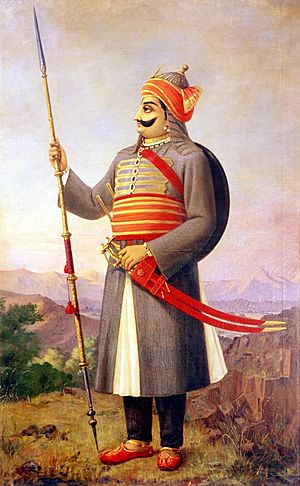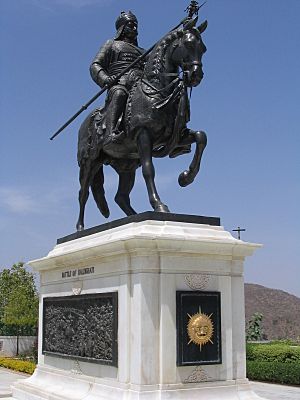Maharana Pratap facts for kids
Quick facts for kids Maharana Pratap |
|||||
|---|---|---|---|---|---|
| Maharana Mewari Rana Kika |
|||||

Portrait of Maharana Pratap
|
|||||
| Reign | 1572 – 1597 | ||||
| Coronation | 28 February 1572 | ||||
| Predecessor | Udai Singh II | ||||
| Successor | Amar Singh I | ||||
| Ministers | Bhamashah | ||||
| Born | 9 May 1540 Kumbhalgarh, Mewar (present day: Kumbhal Fort, Rajsamand District, Rajasthan, India) |
||||
| Died | 19 January 1597 (aged 56) Chavand, Mewar (Present day:Chavand, Udaipur District, Rajasthan, India) |
||||
| Spouse | 11 including:
|
||||
| Issue | 22 (including Amar Singh I and Bhagwan Das) and 5 daughters | ||||
|
|||||
| Dynasty | Sisodias of Mewar | ||||
| Father | Udai Singh II | ||||
| Mother | Maharani Jaiwanta Bai | ||||
| Religion | Hinduism | ||||
Maharana Pratap (born around May 9, 1540 – died January 19, 1597) was a brave king from the Mewar region of India. He belonged to the Sisodia family. Maharana Pratap is famous for fighting against the powerful Mughal Empire, led by Emperor Akbar. He used clever guerrilla warfare tactics, which inspired many others who later fought against the Mughals, like Shivaji.
Contents
Maharana Pratap's Early Life and Becoming King
Maharana Pratap was born to Udai Singh II, the king of Mewar, and his mother, Jaiwanta Bai. He had two younger brothers, Shakti Singh and Vikram Singh, and a stepbrother named Jagmal Singh. Pratap also had two stepsisters, Chand Kanwar and Man Kanwar. His main wife was Ajabde Punwar.
When his father Udai Singh died in 1572, there was a question about who would be the next king. Udai Singh wanted his son Jagmal to take over. However, the important people in the court preferred Pratap because he was the eldest son. So, Pratap became the 54th ruler of Mewar, continuing the line of the Sisodia Rajputs. Jagmal was very angry and went to Ajmer to join Emperor Akbar's army. As a reward for his help, Jagmal received the town of Jahazpur.
Military Challenges and Battles
Why Mewar Fought the Mughals
Unlike many other Rajput rulers, the state of Mewar, led by Maharana Pratap, refused to make alliances with the Mughal Empire. They resisted Mughal rule and did not want to be controlled by them. This led to many conflicts between Maharana Pratap and Emperor Akbar, especially the famous Battle of Haldighati.
The Battle of Haldighati
The Siege of Chittorgarh in 1567-1568 had already caused Mewar to lose its fertile eastern lands to the Mughals. However, Maharana Pratap still controlled the hilly and forested parts of his kingdom in the Aravalli Range. Emperor Akbar wanted to secure a safe route to Gujarat through Mewar. When Pratap became king in 1572, Akbar sent several messengers, including Raja Man Singh of Amer, asking Pratap to become a vassal (a ruler who accepts the authority of a more powerful king), like many other Rajput rulers. But Pratap refused to personally submit to Akbar, which made war unavoidable.
The Battle of Haldighati took place on June 18, 1576. It was fought between Maharana Pratap's forces and the Mughal army, led by Man Singh I of Amer. The battle happened in a narrow mountain pass called Haldighati, near Gogunda in modern-day Rajasthan.
Pratap's army had about 3,000 cavalry (soldiers on horseback) and 400 Bhil archers (skilled bowmen). The Mughal army, led by Man Singh, was much larger, with around 10,000 men. After a fierce fight that lasted over three hours, Pratap was wounded, and his side was losing. He managed to escape to the hills and lived to fight another day.
Even though the Mughals won the battle, it was not a complete victory for them. They could not capture or kill Maharana Pratap or any of his close family members. While Man Singh did take control of Gogunda shortly after the battle, Akbar himself had to lead a long campaign against Pratap in September 1576. Soon, Gogunda, Udaipur, and Kumbhalgarh were all under Mughal control.
Taking Back Mewar
After 1579, the Mughal pressure on Mewar lessened. This was because there were rebellions in Bengal and Bihar, and Mirza Muhammad Hakim invaded the Punjab. Taking advantage of this, Maharana Pratap attacked and captured the Mughal post at Dewair (or Dewar) in the Battle of Dewair in 1582. This victory led to the quick removal of all 36 Mughal military outposts in Mewar.
After this, Akbar sent another general, Jagannath Kachhwaha, to invade Mewar in 1584. But again, the Mewar army defeated the Mughals and forced them to retreat. In 1585, Akbar moved to Lahore and stayed there for twelve years, focusing on the situation in the northwest. During this time, no major Mughal army was sent to Mewar.
Maharana Pratap used this opportunity to take back most of Mewar. He recaptured many areas, except for the former capital, Chittorgarh, and the Mandalgarh regions. During this time, he also built a new capital called Chavand, which is near modern Dungarpur.
Maharana Pratap's Legacy
Supporting Art and Culture
Maharana Pratap's court in Chavand was a place where many poets, artists, writers, and craftspeople found support. The Chavand school of art, a unique style of painting, developed during his rule.
The Revival of Mewar
Maharana Pratap found safety in the Chappan area and began to attack Mughal strongholds from there. By 1583, he had successfully captured western Mewar. This included places like Dewar, Amet, Madariya, Zawar, and the fort of Kumbalgarh. He then made Chavand his capital and built a Chamunda Mata temple there.
Maharana Pratap was able to live in peace for a short time and began to bring order back to Mewar. From 1585 until his death, he recovered a large part of his kingdom. People who had left Mewar during the wars started to return. There were good monsoons, which helped farming in Mewar recover. The economy also improved, and trade increased in the area. Maharana Pratap was able to capture the territories west of Chittor, but he could not fulfill his dream of taking back Chittor itself.
Death of a King
Maharana Pratap reportedly died from injuries he got in a hunting accident. This happened at Chavand on January 19, 1597, when he was 56 years old. His eldest son, Amar Singh I, became the next king. On his deathbed, Pratap told his son never to give up to the Mughals and to win Chittor back.
A Lasting Inspiration
Maharana Pratap is a very important figure in the folk stories and modern culture of that state. He is seen as a celebrated warrior not just in Rajasthan but across India.
In 2007, a statue of Maharana Pratap was revealed by former President Pratibha Patil in the Parliament of India. This shows how much he is respected even today.
See also
- Rajput resistance to Muslim conquests
- Udaipur State
- Durgadas Rathore
 In Spanish: Maharana Pratap para niños
In Spanish: Maharana Pratap para niños


